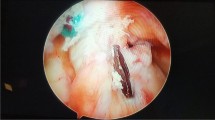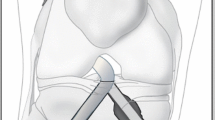Abstract
Purpose
Recent studies have emphasized the importance of anatomical ACL reconstruction to restore normal knee kinematics and stability. Aim of this study is to evaluate and compare the ability of the anteromedial (AM) and transtibial (TT) techniques for ACL reconstruction to achieve anatomical placement of the femoral and tibial tunnel within the native ACL footprint and to determine forces within the graft during functional motion. As the AM technique is nowadays the technique of choice, the hypothesis is that there are significant differences in tunnel features, reaction forces and/or moments within the graft when compared to the TT technique.
Methods
Twenty ACL-deficient patients were allocated to reconstruction surgery with one of both techniques. Postoperatively, all patients underwent a computed tomography scan (CT) allowing 3D reconstruction to analyze tunnel geometry and tunnel placement within the native ACL footprint. A patient-specific finite element analysis (FEA) was conducted to determine reaction forces and moments within the graft during antero-posterior translation and pivot-shift motion.
Results
With significantly shorter femoral tunnels (p < 0.001) and a smaller inter-tunnel angle (p < 0.001), the AM technique places tunnels with less variance, close to the anatomical centre of the ACL footprints when compared to the TT technique. Using the latter, tibial tunnels were more medialised (p = 0.007) with a higher position of the femoral tunnels (p = 0.02). FEA showed the occurrence of higher, but non-significant, reaction forces in the graft, especially on the femoral side and lower, however, statistically not significant, reaction moments using the AM technique.
Conclusion
This study indicates important, technique-dependent differences in tunnel features with changes in reaction forces and moments within the graft.
Level of evidence
II.






Similar content being viewed by others
References
Aga C, Wilson K, Johansen S, Dornan G, La Prade R, Engebretsen L (2017) Tunnel widening in single- versus double-bundle anterior cruciate ligament reconstructed knees. Knee Surg Sports Traumatol Arthrosc 25(4):1316–1327
Amis A, Jakob R (1998) Anterior cruciate ligament graft positioning, tensioning and twisting. Knee Surg Sports Traumatol Arthrosc 6:S2–S12
Arno S et al (2016) Does anteromedial portal drilling improve footprint placement in anterior cruciate ligament reconstruction? Clin Orthop Relat Res 474(7):1679–1689
Bernard M, Hertel P, Hornung H, Cierpinski T (1997) Femoral insertion of the ACL. Radiographic quadrant method. Am J Knee Surg 10(1):14–22
Bischoff J (2008) Advanced material modeling in a virtual biomechanical knee. Abaqus Users’ conference. Newport, Rhode Island
Bull A, Amis A (1998) The pivot-shift phenomenon: a clinical and biomechanical perspective. Knee 3(5):141–158
Clockaerts S, Van Haver A, Verhaeghen J, Vuylsteke K, Leenders T, Lagae KC, Verdonk P (2016) Transportal femoral drilling creates more horizontal ACL graft orientation compared to transtibial drilling: a 3D CT imaging study. Knee 23(3):412–419
Desai N, Andernord D, Sundemo D, Alentorn-Geli E, Musahl V, Fu F, Forssblad M, Samuelsson K (2017) Revision surgery in anterior cruciate ligament reconstruction: a cohort study of 17.682 patients from the Swedish National knee ligament register. Knee Surg Sports Traumatol Arthrosc 25(5):1542–1554
Kaiser J, Vignos M, Kijowski R, Baer G, Thelen D (2017) Effect of loading on in vivo tibiofemoral and patellofemoral kinematics of healthy and ACL-reconstructed knees. Am J Sports Med 45(14):3272–3279
Lubowitz JH et al (2014) Anatomic ACL reconstruction produces greater graft length change during knee range-of-motion than transtibial technique. Knee Surg Sports Traumatol Arthrosc 22(5):1190–1195
Mai H, Chun D, Schneider A, Erickson B, Freshman R, Kester B, Verma N, Hsu W (2017) Performance-based outcomes after anterior cruciate ligament reconstruction in professional athletes differ between sports. Am J Sports Med 45(10):2226–2232
Marumo K, Saito M, Yamagishi T (2005) The “ligamentization” process in human anterior cruciate ligament reconstruction with autogenous patellar and hamstring tendons. Am J Sports Med 33:1166–1173
Nawabi D, Tucker S, Schafer K, Zuiderbaan H, Nguyen J, Wickiewicz T, Imhauser C, Pearle A (2016) ACL fibers near the lateral intercondylar ridge are the most load bearing during stability examinations and isometric through passive flexion. Am J Sports Med 44(10):2563–2571
Osti M, Krawinkel A, Ostermann M, hoffelner T, Benedetto K (2015) Femoral and tibial graft tunnel parameters after transtibial, anteromedial portal, and outside-in single-bundle anterior cruciate ligament reconstruction. Am J Sports Med 43(9):2250–2258
Parkar AP, Adriaensen M, Vindfeld S, Solheim E (2017) The anatomic centers of the femoral and tibial insertions of the anterior cruciate ligament. Am J Sports Med 45(9):2180–2188
Rahr-Wagner L, Thillemann T, Pedersen A, Lind M (2013) Increased risk of revision after anteromedial compared with transtibial drilling of the femoral tunnel during primary anterior cruciate ligament reconstruction: results from the Danish knee ligament reconstruction register. Arthroscopy 29(1):98–105
Riboh J, Hasselblad V, Godin J, Mather R (2013) Transtibial versus independent drilling techniques for anterior cruciate ligament reconstruction: a systematic review, meta-analysis and meta-regression. Am J Sports Med 41(11):2693–2702
Robin B, Jani S, Marvil S, Reid J, Schillhammer C, Lubowitz J (2015) Advantages and disadvantages of transtibial, anteromedial portal, and outside-in femoral tunnel drilling in single-bundle anterior cruciate ligament reconstruction. Arthroscopy 31(7):1412–1417
Sepúlveda F, Sánchez L, Amy E, Micheo W (2017) Anterior cruciate ligament injury: return to play, function and long-term considerations. Curr Sports Med Rep 16(3):172–178
Siebold R, Ellert T, Metz S, Metz J (2008) Femoral insertions of the anteromedial and posterolateral bundles of the anterior cruciate ligament. Arthroscopy 24(5):585–592
Tampere T, Van Hoof T, Cromheecke M, Van der Bracht H, Chahla J, Verdonk P, Victor J (2017) The anterior cruciate ligament: a study on its bony and soft tissue anatomy using novel 3D CT technology. Knee Surg Sports Traumatol Arthrosc 25(1):236–244
Wang H, Fleischli J, Hutchinson I, Zheng N (2014) Knee moment and shear force are correlated with femoral tunnel orientation after single-bundle anterior cruciate ligament reconstruction. Am J Sports Med 42(10):2377–2385
Wang J, Kim J, Lee do K, Lim H, Ahn J (2012) Comparison of femoral graft bending angle and tunnel length between transtibial technique and transportal technique in anterior cruciate ligament reconstruction. Knee Surg Sports Traumatol Arthrosc 20(8):1584–1593
Xie F, Yang L, Guo L, Wang Z, Dai G (2009) A study on construction three-dimensional nonlinear finite element model and stress distribution analysis of anterior cruciate ligament. J Biomech Eng 131(12):1210
Xu Y, Liu J, Kramer S et al (2011) comparison of in situ forces and knee kinematics in anteromedial and high anteromedial bundle augmentation for partially ruptured anterior cruciate ligament. Am J Sports Med 39(2):272–278
Funding
No funding was received for this study
Author information
Authors and Affiliations
Corresponding author
Ethics declarations
Conflict of interest
The authors declare that they have no conflict of interest.
Ethical approval
The study was approved by the ethical committee of the University Hospital of Ghent (EC UZG 2012/324–2013/375 - B670201317506).
Rights and permissions
About this article
Cite this article
Tampere, T., Devriendt, W., Cromheecke, M. et al. Tunnel placement in ACL reconstruction surgery: smaller inter-tunnel angles and higher peak forces at the femoral tunnel using anteromedial portal femoral drilling—a 3D and finite element analysis. Knee Surg Sports Traumatol Arthrosc 27, 2568–2576 (2019). https://doi.org/10.1007/s00167-018-5272-0
Received:
Accepted:
Published:
Issue Date:
DOI: https://doi.org/10.1007/s00167-018-5272-0




